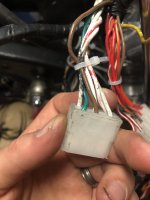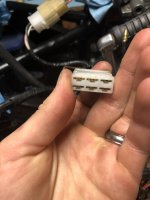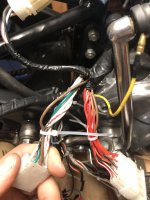Copy that I don’t really know how to tell if the brushes are good or not but I can tell they’re old so I’m gonna get some coming regardless and hope that’s it then next step learn how to test the regulator.
Its always good to have a spare set of brushes with you (
these danged things always seem to fail in the middle of nowhere with a girl on the back....at night, in the frickin' rain...the night before thermo examination - DAMHIK) - but before you change them, have a good look and get a ruler out.
The better-made brushes will have a line scribed on them across one or two of the sides at right angles to the long axis. That line is a wear limit indicator (
you can see it on the lower brush in the photo below adjacent to the "3" on the scale) and as long as the brush is longer than that, they are OK to re-use. I think the limit is 7 mm (or about 5/16") - and if you can see the line plus a bit, just polish up the end with some fine sandpaper and stick 'em back in.
You should also clean the two concentric slip rings on the alternator rotor while you are at it.
I haven't had to replace the brushes very often on my bikes these days. I just check them at the beginning of every season and as long as they are well ahead of the wear limit, I reinstall them. However, I had a 1975 XS650B back in the 70's when I was a student and that thing chewed brushes like clockwork about every 6-9,000 miles (and I rode it
A LOT). I suspect that the alternator slip rings were rough - but honestly, I never thought to look. I just started carrying brushes and a screwdriver and changed them whenever the bike became hard to start.
One other thing -
DO NOT fall for the
PMA trap as a means of eliminating the brushes. Those systems are expensive and do not seem to stand up well and a lot of people have had a lot of frustration with them. By the way, PMA stands for Permanent Magnet Alternator <I think> and they are the norm on modern bikes - but the aftermarket XS650 units don't last.
The only real upgrades to the existing charging system that might be useful are:
- a modern voltage regulator and/or rectifier (the rectifier lives on the underside of the battery box and is often corroded and ruined by a leaking battery). I use a combo rec-reg unit but a lot of folks buy separate ones and they work just fine too (search on the forum for how-to's)
- a re-wound alternator rotor - and the best choice by a country mile is our own Jim - the forum guy with the WW-2 American army helmet. Jim has built his own tooling to clean and rewind XS650 rotors and when you get one from him - it WILL work perfectly. He has a thread on the forum - his prices are reasonable and his work is simply ....perfect.

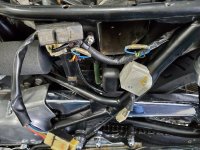
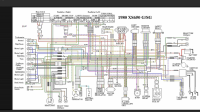
 ), I got her running and everything was working perfect - and then about two weeks later, the fuse would blow every time I signaled a left turn. Right turns were OK - just lefts. I found that the left-rear signal wire had rubbed on that little burr - and it was shorting out whenever power was applied to the signal. Since the '76 has only one fuse, it knocked out the entire bike. The cure was easy: just disassemble each signal stalk and de-burr both ends of that piece of threaded rod with a suitable piece of emory cloth or sandpaper. The whole shebang took about an hour - an easy two-beer job.
), I got her running and everything was working perfect - and then about two weeks later, the fuse would blow every time I signaled a left turn. Right turns were OK - just lefts. I found that the left-rear signal wire had rubbed on that little burr - and it was shorting out whenever power was applied to the signal. Since the '76 has only one fuse, it knocked out the entire bike. The cure was easy: just disassemble each signal stalk and de-burr both ends of that piece of threaded rod with a suitable piece of emory cloth or sandpaper. The whole shebang took about an hour - an easy two-beer job.